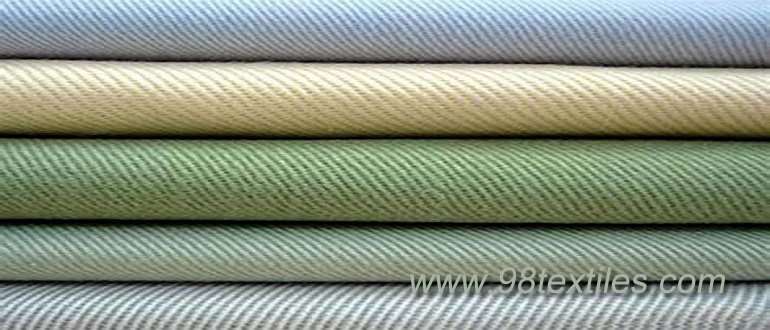Fabrics Series


Cotton Twill Fabrics Khaki Gabardine
For Suits, Uniforms, Pants, Trousers, Jackets, Overcoats, and other garmentsTwill is a type of textile weave with a pattern of diagonal parallel ribs. It is one of three fundamental types of textile weaves along with plain weave and satin. It is made by passing the weft thread over one or more warp threads then under two or more warp threads and so on, with a "step," or offset, between rows to create the characteristic diagonal lines pattern. This diagonal pattern is also known as a wale. Because of this structure, twill generally drapes well.
Twill fabrics technically have a front and a back side, unlike plain weave, whose two sides are the same. The front side of the twill is called the technical face and the back the technical back. The technical face side of a twill weave fabric is the side with the most pronounced wale; it is usually more durable and more attractive, is most often used as the fashion side of the fabric, and is the side visible during weaving. But twill fabrics have no "up" and "down" as they are woven.
Soiling and stains are less noticeable on the uneven surface of twills than on a smooth surface, such as plain weaves, and as a result, twills are often used for sturdy work clothing and for durable upholstery. Denim, for example, is a twill.
The fewer interlacings in twills as compared to other weaves allow the yarns to move more freely, and therefore they are softer and more pliable and drape better than plain-weave textiles. Twills also recover from creasing better than plain-weave fabrics do. When there are fewer interlacings, the yarns can be packed closer together to produce high-count fabrics. With higher counts, including high-count twills, the fabric is more durable, and is air- and water-resistant.
Twills can be divided into even-sided and warp-faced. Even-sided twills include foulard or surah, herringbone, houndstooth, serge, sharkskin, and twill flannel. Warp-faced twills include cavalry twill, chino, covert, denim, drill, fancy twill, gabardine (the density of warp is twice than weft), and lining twill.
Twill is known for being durable, not wrinkle easily, and easy to spot clean as well as machine-wash. So twill fabric is suitable for suits, uniforms, pants and jeans throughout the year, and for durable jackets, overcoats, windbreakers in the fall and winter. Lighter weight twill can also be found in neckties and spring dresses.
Normal Specifications of Cotton Twill Fabrics:
| Item | Name | Material | Yarn Count / Density | Texture | ||
|---|---|---|---|---|---|---|
| 1121-01 | Twill Fabric | 100% Cotton T/C 65%/35% CVC 50%/50% | 20s×20s / 108×58; | 2/2 Twill 3/1 Twill Herringbone |
||
| 1121-02 | Twill Fabric | 21s×21s / 108×58; | ||||
| 1121-03 | cotton Khaki | 20s×16s / 128×60; | ||||
| 1121-04 | Cotton Khaki | 16s×12s / 108×56; | ||||
| 1121-05 | Khaki Fabric | 7s×7s / 68×38; | ||||
| 1121-06 | Khaki Fabric | 24s×24s / 96×64; | ||||
| 1121-07 | Serge Fabric | 30s×30s / 130×70; | ||||
| 1121-08 | Khaki Drill | 28s×28s / 144×76 | ||||
| 1122-01 | Gabardine Fabric (Semi-thread) | (40s/2)×16s / 128×60; | ||||
| 1122-02 | Twill Fabric (Semi-thread) | (32s/2)×12s/108×56; | ||||
| 1122-03 | Khaki Fabric (Semi-thread) | (60s/2) ×30s/144×76; | ||||
| 1122-04 | Gabardine Fabric (Semi-thread) | (32s/2)×10s/112×54; | ||||
| 1123-01 | Twill Fabrics (thread) | (40s/2)×(40s/2)/108×58; | ||||
| 1123-02 | Gabardine Fabrics (thread) | (40s/2)×(32s/2)/128×60; | ||||
| 1123-03 | Khaki Fabrics (thread) | (60s/2)×(60s/2)/144×76; | ||||
| Post-treatment:Bleached /Solid Dyed /Printed /Preshrunk /Sand Wash /Soften /Fireproof /Coated More style or specifications will be offered or made as per customer's request. | ||||||












